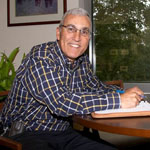The ad industry loves this trait in Buffagni as he conceptualizes thought-provoking campaigns on an international scale.
For Pablo Buffagni, the answers are out there; he just has to be willing to look for them—differently. Since he was a boy growing up in Buenos Aires, the world has been his kaleidoscope, waiting for him to shuffle the contents and see something new. He grew up reading the stories of Argentine author Julio Cortázar and was fascinated by the magic of surrealism. He was inspired by Cortázar’s book Rayuela, which can be read multiple ways with different beginnings and ends. Through literature, Buffagni learned to think and create in unconventional ways.
After short stints as a judo teacher, dog walker, and children’s-party magician, he found his niche in advertising. “I had the opportunity to work at an agency at a young age,” Buffagni says, “and I loved the world of advertising. From that moment on, I decided my future was to be an advertising creative.” It was a choice the ad industry is glad he made, and one that’s shaped creative work on an international scale.
Thinking Out Loud
Trading words with Pablo Buffagni
Success
Being happy with the things that you are able to do and the people who surround you
Innovation
What moves us ahead
Integrity
More present in the advertising industry that I work in today
Latino
Being Latino gives you great chances to succeed in the United States because it means being center stage in what’s happening in the country
One of Buffagni’s most successful campaigns came from an observation people make every day, but Buffagni’s interpretation brought it to life. “If you look at people’s cars,” Buffagni says, “they always have something that shows their origin, be it university decals or license plates.” Buffagni and his team saw Toyota owners as the population at large. Though they all drive the same brand, they come from a variety of backgrounds. The parallel was drawn and Conill, the advertising firm for which he was working, launched the “Somos Muchos” campaign. With 99 free window stickers to choose from, the campaign represented pan-Hispanic nationalities and regional ties with phrases such as, “Somos muchos Latinos. Somos muchos Toyota.”
“We uncovered something relevant that people could connect to,” Buffagni explains. And consumers did relate: more than 450,000 stickers strong. Advertising Age reported that in the first four months after the stickers were offered, Toyota experienced a 13 percent improvement in favorable opinion—a great accomplishment any way you look at it.
In 2008, Buffagni earned high marks for Toyota with a Cannes Lion-winning video sponsorship, which represented the first festival title awarded to an American Hispanic agency in the media category. And two years later he brought home a Gold Lion, the most prestigious title, for his Argentina New Cinema ad. Combined with recognition at the CLIOS, Effies, and a handful of other notable media competitions, these accomplishments are a testament to the visionary work that Buffagni is know for, and for which he was sought by the Huntington Beach, Californa-based Grupo Gallegos.
In less than a year since joining the independent agency, whose clientele include Comcast, Valvoline, Target, and the California Milk Processor Board, Buffagni has already left his impression. His first major project, a campaign to promote milk drinking, bears the undeniable influence of his favorite childhood stories.
What Buffagni has tapped into—as he has times before—is the sentimentality of milk and the experience of drinking it. Buffagni’s campaign is a series of bedtime stories to enjoy with a glass of milk. While looking at the stars, Sofía, one of the main characters, wishes she could drink them with a straw on the hunch that they’re made of the cool dairy beverage. By the end of the story—and the bottom of the glass—Sofía claims she was right all along. And when her mother asks why, the girl responds, “Why do you think they call it the Milky Way?”
“It’s a very nice story with magic for kids,” Buffagni says. “But, there’s a connection between the parents and kids.” While some may admire the imaginative nature of the idea, Buffagni can always boil his work down to one main premise: “Everything goes back to human connections,” he says. “That’s something that works for everybody.”

